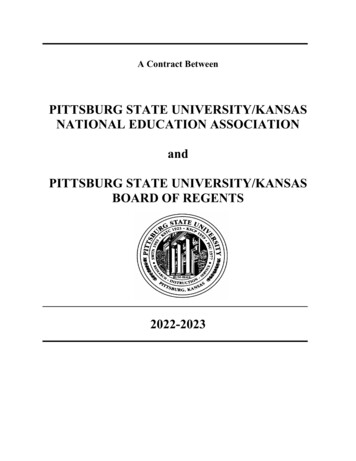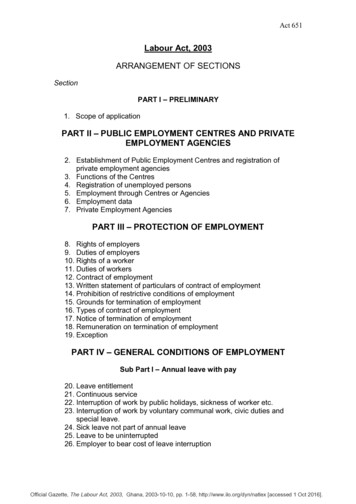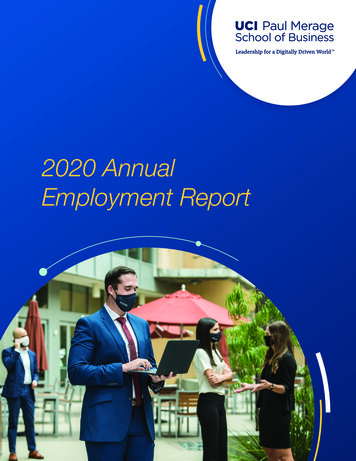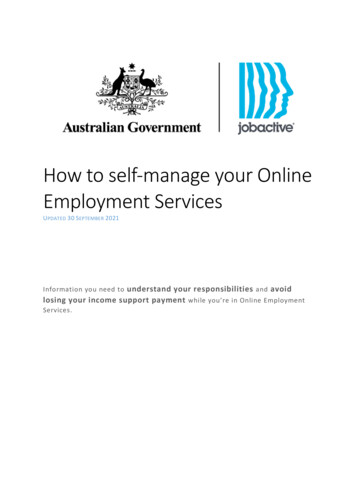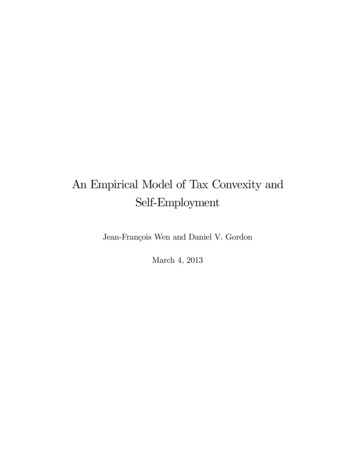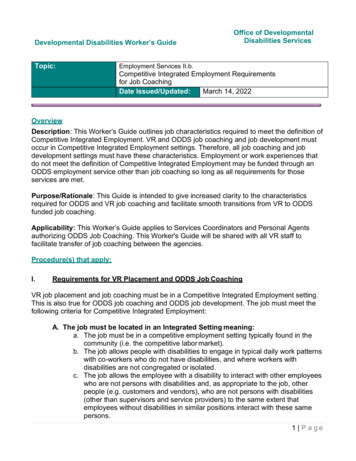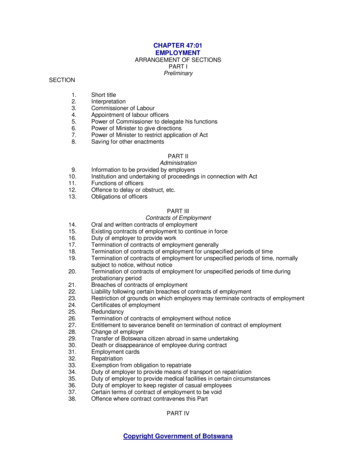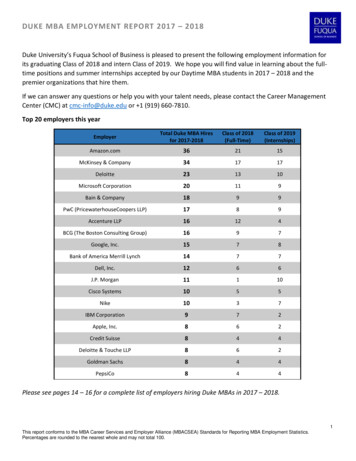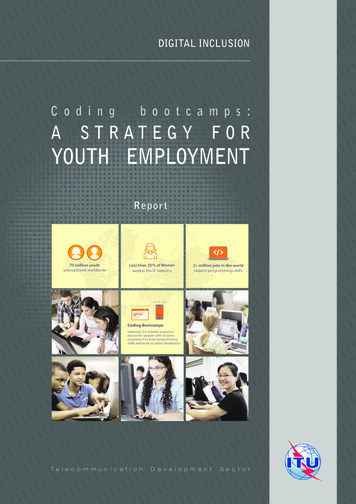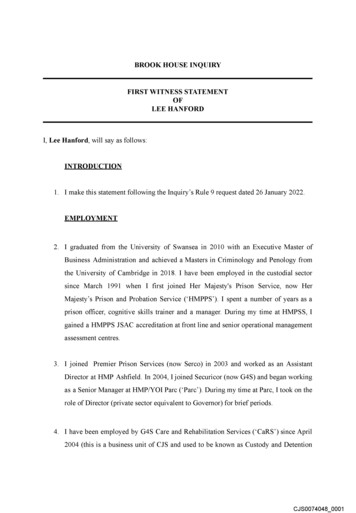
Transcription
BROOK HOUSE INQUIRYFIRST WITNESS STATEMENTOFLEE HANFORDI, Lee Hanford, will say as follows:INTRODUCTION1. I make this statement following the Inquiry's Rule 9 request dated 26 January 2022.EMPLOYMENT2. I graduated from the University of Swansea in 2010 with an Executive Master ofBusiness Administration and achieved a Masters in Criminology and Penology fromthe University of Cambridge in 2018. I have been employed in the custodial sectorsince March 1991 when I first joined Her Majesty's Prison Service, now HerMajesty's Prison and Probation Service ('HMPPS'). I spent a number of years as aprison officer, cognitive skills trainer and a manager. During my time at HMPSS, Igained a HMPPS JSAC accreditation at front line and senior operational managementassessment centres.3. I joined Premier Prison Services (now Serco) in 2003 and worked as an AssistantDirector at HMP Ashfield. In 2004, I joined Securicor (now G4S) and began workingas a Senior Manager at HMP/YOI Pare ('Pare'). During my time at Pare, I took on therole of Director (private sector equivalent to Governor) for brief periods.4. I have been employed by G4S Care and Rehabilitation Services ('CaRS') since April2004 (this is a business unit of CJS and used to be known as Custody and DetentionCJS0074048 0001
Services ('C&DS'). During this time, I have been employed in a number of roles suchas:1. Business Development & Bid Manager from 2006 until 2011. I managed theoperational transition of Dungavel IRC from Serco to G4S during this periodand supported the site as Mobilisation Director from August 2006 untilFebruary 2007. I also managed the bids for new prison contracts for G4S andmaintained an operational Duty Director role at Pare during this period.2. Business Development and Mobilisation, Transition and TransformationDirector from 2011 until April 2014. I was involved in mobilising operationalcontracts following successful bid wins. I was also one of three G4S GoldCommanders.3. Operational Development Director from April 2014 until July 2016. I wasseconded as Director of Gatwick Immigration Removal Centres from 1February 2016 until 30 June 2016. I covered this secondment as the Directorhad been seconded to Medway STC. I remained in my role as G4S GoldCommander.4. Business Change Director from July 2016 until July 2019. During this period Iwas seconded as Interim Director of Gatwick Immigration Removal Centresfollowing the airing of the Panorama documentary. I was in this role from 25September 2017 until 24 September 2018. I remained in my role as G4S GoldCommander.5. Operational Support Director between July 2019 and February 2021. Iremained in my role as G4S Gold Commander.6. Chief Operating Officer (CaRS) from February 2021. I also continue in myrole as G4S Gold Commander.APPOINTMENT AS INTERIM DIRECTOR AT GATWICK IRCsCJS0074048 0002
5. The Director position at Gatwick IRCs became vacant due to the then Director, BenSaunders, being seconded to another establishment. I was appointed as InterimDirector on 1 February 2016 as I had previous management experience within thecustodial sector and also experience of the IRC estate in my previous role asOperational Development Director (and in my previous deployment at Dungavel IRC)and role of Gold Commander. I also had a good working relationship with the HomeOffice, and had been working with them to address the Stephen Shawrecommendations.6. I understood that the role was to take responsibility for the management of BrookHouse, Tinsley House and Cedars PDA (initially for a 3 month secondment, whichwas extended for a further 3 months) to ensure a safe and decent environment for bothdetainees and staff It was also my responsibility to provide strategic and operationalleadership to deliver the contract.7. I left the role on 30 June 2016 when Ben returned from secondment, although I wasreappointed on an interim basis (pending a full-time replacement) on 25 September2017 following Ben's departure (Ben's departure is explained in more detail inparagraph 17 of the CJS corporate witness statement). I left on 24 September 2018following the appointment of Phil Wragg.SHAW REPORT RECOMMENDATIONS8. I am asked to confirm the extent of my involvement with the Shaw Reportrecommendations9. I was not directly involved in the Shaw Report recommendations. I attended theknowledge exchange workshop on 27 June 2016 at the Centre for Criminology,University of Oxford. The meeting attendees included Stephen Shaw, Kate Lampard,Ed Marsden, Mary Bosworth and the representatives from service delivery providersCJS0074048 0003
including G4S, Serco and academics. The sess10n focused on the report and thelearnings from the Verita review of Yarl's Wood IRC.10. Prior to this meeting, the Shaw report recommendations were shared with ServiceProviders and a part of my role as the Operational Development Director was tosupport and monitor Contract Directors to improve service delivery across the G4Scustodial estate, which from an IRC perspective, included supporting the Gatwickteam to address and implement the recommendations.INTERACTION WITH BROOK HOUSE DURING THE RELEVANT PERIOD11. During 2017, I was Gold Commander for G4S. The role and responsibilities includedbeing responsible and accountable for the management of serious incidents, strategicoversight and overall command and responsibility of such incidents. I would alsocontribute to any lessons learned post-incident. I would also set the tacticalparameters and ensured that the Silver Commander managed the tacticaldecision-making for my approval. I identified the level of response required to resolveany serious incident and engaged with stakeholders such as the Home Office andHMPPS Gold Command to assist in resourcing the response if required. I alsoinformed and updated internal and external stakeholders regarding any senousincidents.12. I cannot recall any specific visits to Brook House during the Relevant Period. I wouldhowever normally attend approximately once per quarter, primarily to inform theoperational solution regarding the rebid of Gatwick IRCs. I would attend followingany serious incident. I would attend on other occasions such as to hear grievances andattend contract review meetings etc. and to support the Director and the seniormanagement team.CJS0074048 0004
13. I would have met the senior management team at trading review meetings. My role atthose meetings was to analyse operational performance that was reported by theDirector and the senior management team.14. The Brook House senior management team would have met with the Home Officeand other service providers such as healthcare and other contractors on a regular basis.The senior management team would also meet with the Home Office Monitors on adaily basis and the Home Home Office Area Managers on a monthly basis duringMCRM (Monthly Contract Review Meetings) and quarterly at the QCRM (QuarterlyContract Review Meetings). I attended one QCRM during the relevant period on 20April 2017.15. I have been referred to document CJS004583 and asked to comment on how BrookHouse's performance was measured. The performance was typically monitored viathe daily, weekly, monthly and quarterly review meetings. The example within theCJS004583 demonstrates how performance points were typically calculated. This is aNotice of Performance for August 2017, which describes the operational failures forthe month. This captures the number of points allocated for each failure, resulting in afinancial penalty against the contractual service delivery expectations. This would bepresented by the Home Office following the monthly meeting, where each of theself-reported and identified failures and mitigations would have been discussed tounderstand the causation of the failures.MANAGEMENT STRUCTURE AT BROOK HOUSE16. I have been asked to look at document CJS000494 and am asked to set out themanagement structure whilst I worked there.17. During 1 February 2016 to 30 June 2016, Steve Skitt reported directly to me asInterim Director of Gatwick IRCs. Steve was Deputy Director and Neil Davies, Headof Security, Michelle Smith, Head of Care and Regimes and Juls Williams,CJS0074048 0005
Residential Manager and Stacie Dean, Head of Tinsley House reported directly tohim. Sarah Newland, Head of Cedars PDA, Michelle Fernandes, Head of HR,Kalpesh Mistry, Finance and Commercial Manager and Mike Bird, FM Manager alsoreported directly to me as the Interim Director of Gatwick IRCs.18. During 25 September 2017 to 24 September 2018, Steve Skitt reported directly to me.Michelle Brown, Head of Security, Juls Williams, Residential Manager, DanHaughton, Support Services Manager and Sarah Newland reported directly to Steve.Mark Demian was appointed as Head of Safeguarding in December 2017. JulsWilliams was employed until July 2018 as Residential Manager and was laterreplaced by Mark Demian as Head of Residence and Resettlement, and Sara Edwardswas appointed as Safeguarding Manager. Michelle Fernandes (HR), Kalpesh Mistry(Commercial and Finance) and Mark Francis (FM) reported directly to me as theInterim Director Gatwick IRCs.STAFF MANAGEMENT AND RELATIONSHIPS19. I am asked to explain my working relationship with, professional opinion of andknowledge of any grievances against various member of staff20. Ben Saunders: I maintained a good professional working relationship with Ben. Benalways endeavoured to deliver an effective and efficient service and focused a lot ofhis attention on managing upwards. He encouraged his senior team to manage failuresin a robust style. At times, in my opinion he could be clumsy in his engagement withothers whilst striving to deliver the service. This is evident in the number ofgrievances that Ben was subject to from his senior management team.21. Ben had been subject to a number of grievances from senior managers reporting tohim and I had been commissioned by Jerry Petherick (the MD at the time) toinvestigate the claims made by Wayne Debnam, Duncan Partridge and Stacie Dean. Iconducted the investigations by interviewing the complainants and other stakeholdersCJS0074048 0006
and shared the findings with the Commissioning Officer, Jerry Petherick. I can notcomment on the outcomes of the grievances as these were managed by Jerry.22. Steve Skirt: I had a very good working relationship with Steve. I worked with him fora number of years when he was the Head of Security at HMP Birmingham. He wasvery competent in this role and delivered effectively. Steve then transferred to HMPAltcourse as Head of Security before being promoted to Head of Brook House andDeputy Director of Gatwick IRCs.23. Steve's approachduring critical business meetings was one of quiet counsel.However, he called on his prior knowledge and experience in order to deliver results.During my first period at Brook House, Steve would accompany me when walkingaround the centre and it was apparent that he had a good working relationship with themajority of the staff and managers. During my second deployment to Brook House, Icould see that Steve was dealing with misdemeanours in a very robust style. Iunderstand that the relationships between a number of senior managers had becomequite chaotic igniting a number of grievances which inevitably set the tone amongstthe staff groups.24. I advised Steve that I wanted to invest in staff who had made mistakes by focusing ontheir development as opposed to taking an overly disciplinary approach, whichseemed to have become the norm. Steve accepted the revised approach, which was todevelop a learning and development approach. I believed that too much activity wasflowing through Steve, hence me making changes to the management structure forBrook House and Tinsley House.25. I am aware that Steve had been subject to a grievance submitted by DCO DavidWaldock. This grievance was submitted to the CEO of G4S and was conducted by theG4S Assurance Team. Whilst there were most certainly lessons learned from suchgrievances, it was apparent that Steve had managed this particular issue effectively.The complainant was not satisfied. However, I overturned a dismissal that Steve hadCJS0074048 0007
made and awarded a final written warning, as I believed there were some mitigatingcircumstances.26. Sarah Newland: I had a very good working relationship with Sarah Newland. I hadworked closely with her on a number of projects, including the re-role of Cedars PDAand the relocation of the PDA service from Cedars to Tinsley House. In my opinionSarah was a competent manager who strived to deliver an effective service. Shetransferred from Head of Cedars to Head of Tinsley House and PDA. Whilstmanaging Gatwick IRCs in 2018, I submitted a business case to appoint Sarah as asecond Deputy Director, Head of Tinsley House and PDA to work alongside SteveSkitt as Deputy Director, Head of Brook House. This appointment was made in 2019 .I am not aware of any grievances made against Sarah.27. Sara Edwards: I maintained a healthy working relationship with her during her time asa manager at Tinsley House and when she was deployed to Brook House as theInterim Head of Safeguarding, a post to which I appointed her. I am not aware of anygrievances made against Sara.28. Juls Williams: I maintained a good working relationship with him. During my firstperiod at Gatwick, I commended Juls for his management of a concerted indiscipline,where approximately 25 detainees refused to leave the exercise yard. Juls managedthis effectively to a peaceful resolution. During my second period, it became apparentthat due to increasing demands on service delivery Juls was struggling. Managers whowere reporting to him reinforced this opinion. Areas of service delivery were failingand causing frustrations amongst staff and detainees. Juls was not embracing theinvestment that G4S was making towards his development, despite further supportbeing offered and he left the company in July 2018. I am not aware of any grievancesmade against him.29. Michelle Brown: I maintained a good working relationship with Michelle over anumber of years including the periods prior to my time as Interim Director. When ICJS0074048 0008
was first deployed to Gatwick IRCs, Michelle was absent from work due to workrelated stress. I invited Michelle to meet me off-site and we agreed on a back to workplan. I always admired Michelle's approach, as she was a manager who would attendthe unit to identify the source of an issue when it arose. She had the ability to reflectand provide longer-term solutions. I am not aware of any grievances made against her.30. Dan Haughton: I maintained a good working relationship with Dan. I was part of theinterview panellists who promoted Dan during my first secondment to Gatwick IRCs.I am not aware of any grievances made against Dan.31. Mark Demian: Mark commenced his employment as the Head of Safeguardingpost-Panorama. Mark took to the role like a duck to water. His diligent approach wasone that was identified as a critical skill to deliver the revised vision of the centre. Itwas an approach that focused on settlement, care and resettlement, and Mark wasdeployed to the role of Head of Residence and Resettlement. I am not aware of anygrievances made against him.32. Neil Davis: Neil was Head of Security during my first deployment to Gatwick IRCs.Steve Skitt was Neil's line manager and provided Neil with a lot of support to managethe function. Neil's confidence needed boosting following an escape at Brook House,which occurred in March 2016. Neil responded well to this incident and negotiateddesign changes in order to prevent a similar occurrence. I am aware that Neil wassubject to a number of grievances although I am not aware of the details or theoutcome and understand that he resigned in August 2016. Michelle Brown claims tohave raised concerns with me about Neil (CJS0073671 3), but I cannot recall this,although I do recall a number of staff members had concerns about Neil'sperformance following the escape.33. During a meeting that I chaired on 3 March 2016 (CJS000463, page 1), I stated that"having no Head of Safeguarding at Gatwick is a big risk." I am asked to explainwhat prompted me to make this comment and how it was resolved. I had been atCJS0074048 0009
Gatwick IRCs for just over a month when this meeting took place. I had met with allsenior managers prior to this meeting individually. It was apparent that this role wasstretched and had too many functions, which meant that they could not devotesufficient time and energy to the critical area of safeguarding. Michelle'srecommendation was that a number of her direct reports would be best suited througha Support Services Manager. We therefore employed an additional manager,promoting Dan Haughton to this role and restructuring to enable Michelle to becomeHead of Safeguarding from 2 June 2016.34. During the same meeting, it was agreed that "changes should be immediate regardingthe safeguarding structure" (page 2). I introduced the new structure when I was theInterim Director during my first period of deployment to Gatwick IRCs. Michellebecame the Head of Safeguarding. Sara Edwards was promoted to El ResidentialManager at Tinsley House and Dan Haughton was promoted to El Support Services.35. In a meeting that I chaired on 30 March 2016, I informed the Senior ManagementTeam of a "new proposed organisational structure for Gatwick." (CJS000495, page1). The new proposed structure included the creation of a dedicated Head ofSafeguarding. Once implemented this role was taken up by Michelle Brown asexplained above. It also included the promotion of Sara Edwards, ResidentialManager of Tinsley House and the promotion of Dan Haughton (Support ServicesManager) was created to remove a number of functions from the previous role ofSafety and Regimes.36. In a meeting on 28 April 2016, it was recorded that there was a "new procedure forSecurity DC'Ms" (CJS000510, page 2) and that I was required to sign off the Terms ofReference. There is no correlation between these two actions. The new procedure forDCMs was a local decision by the Head of Security. The Terms of Reference actionwas related to the commissioning of investigations. It was my view that too manymisdemeanours were being subjected to an investigation. I wanted to see all Terms ofReference prepared to triage whether they required investigation or could have beenCJS0074048 0010
dealt with via managerial intervention, training and support. I thought that onlyserious or repeated misdemeanours should be subject to investigation.37. The comment (at page 3) "managers need to be visible and showing support to staff'was made by Steve Skirt. I supported his comment. Steve was keen for managers tospend more time on residential units, not only on the days that they were DutyDirector. It was important for all managers to check-in on areas that they did notmanage in order to challenge each other and to raise and maintain standards.TRADING REVIEW MEETINGS38. Trading Review Meetings were conducted monthly. They were chaired by JerryPetherick. He was supported by Health and Safety, Commercial, HR, Audit andCompliance, Finance and Operational colleagues. The standard agenda was aligned tothe representatives in the meeting. The Centre Director would present and wassupported by the on-site team, including senior managers if issues in their departmentwere flagged as areas of concern for review.SENIOR MANAGEMENT TEAM MEETINGS39. The purpose of the senior management team meetings was to provide a summary ofthe performance of departments and have an awareness of the interdependencies withother departments and were undertaken monthly.40. The senior management team and functional managers prepared their reports prior todiscussing at the senior management team meeting.41. During my first period at Gatwick IRCs, the meetings would last approximately 2.5hours and covered previous actions, departmental updates, audit and compliance,director and deputy director updates and AOB. During my second period at GatwickIRCs, I amended the senior management team meeting agenda to align it with theCJS0074048 0011
Trading Review agenda. I was then able to use it as a preparation for the TradingReview and ensured that all senior managers were aware of the content being reportedwithin the organisation. We covered actions from previous meetings, the Director'sexecutive summary, health, safety and environmental, financial performance,operational performance, incidents, violence and self-harm, assurance, HR, criticalprojects, commercials and sales pipeline, account management, use of force andAOB.42. The meetings were effective. My view was that making use of the Trading Reviewformat brought greater clarity. This ensured the whole of the senior management teamwere focused on critical issues within each department. For example, new membersand roles were brought into the senior management team meeting, such as theManager of Religious Affairs.43. Actions were monitored regularly, as previous actions were discussed at the start ofeach new meeting. If actions were not achieving the desired outcome and this wasreoccurring, we would discuss this with the person responsible for that particularaction. We would try to understand the reasons for this shortfall and what extrasupport they required.STAFFING LEVELS44. Operational colleagues supported the HR team to conduct recruitment days. Whilstrecruitment was challenging, the HR team were successful in attracting candidates.The main concern at Gatwick was the retention of staff, particularly during my seconddeployment and the large amounts of staff that left post-Panorama.45. To overcome this, we engaged with staff and Trade Union to fully understand why wewere experiencing such high levels of attrition. The findings showed that it wasmainly due to long hours and limited support from line managers. I engaged withcolleagues to increase the numbers of staff, managers and associated funding. ThisCJS0074048 0012
ensured that there were at least three DCOs and one DCM deployed to each mainresidential unit. We also engaged with the Trade Union to reduce working hours,which they were, down to 40 without a salary reduction.46. Kate Lampard and Ed Marsden found that there was a "lack of senior managementcapacity" at Brook House (CJS005923, page 77). They were comparing the numberof senior managers at HMP Rye Hill but Brook House did not have the same structureor number of senior managers. There were many significant differences in funding fora long-term Category B prison and what the Home Office procured for the IRC estate.HMP Rye Hill had 17 senior operational managers. When the Verita reviewcommenced, there were three operational senior managers and two middle managersto meet the contractual requirements. My initial view was that there was a lack ofsenior management capacity, we then recruited a fourth senior manager.47. During a meeting that I chaired on 3 March 2016 (CJS000463, page 1), it was notedthat "there is no consistency in security, as staff are being taken away from their jobsto cover other areas." This was the second senior management team meeting that Ihad chaired following my initial appointment at Gatwick IRCs. I had spent a lot oftime reviewing operational processes and found that there was an over reliance onmanagers to provide support to Tinsley House, particularly the Security, Health andSafety and Activity functions. My recommendation was that the DCMs allocated toTinsley House needed to take responsibility for their own environment and be lessdependent on Brook House staff conducting the security and health and safety riskassessments and the planning of the regime.48. I am referred to my Verita interview where I noted that there were insufficientnumbers of DCMs to act as ''jrontline managers" (page 11 and 18 of VER000266)and that this led to a situation in which I was "allowing people of equal grade to tryand manage one another" and am asked to explain the impact of this 'missing part'and the steps taken to resolve it.CJS0074048 0013
49. My response was that: "I'm a firm believer in having DC'Ms because in the absence ofa supervisor, everyone is of equal grade and then you will have some people who arereally keen and will become natural leaders, whereif we had more DC'Ms they mightfind their way into there. They start guiding people to get the job done and people feelaggrieved that somebody in their equal grade is trying to give guidance to get the jobdone." I maintain that position.50. What I was attempting to articulate was that in the absence ofDCMs, there were oftencomplex relationships when peers are attempting to manage their peers. My view wasthat there was a need to increase the number of DCMs (E2 Grade), which wasintroduced. This was initially self-funded before being funded by the Home Office aspart of the contract extension.51. When I was appointed Interim Director in late September 2017, I raised a concern inrelation to DCM staffing numbers. It was apparent that DCMs were struggling withtheir workload and having to manage two residential units. This ultimately meant thatthey were spread too thinly to provide the necessary support to the two staff deployedto each residential unit. I engaged with G4S and the Home Office to increase thenumber of DCMs in the residential areas in order to enable the deployment of oneDCM to each residential unit.52. I shared my idea to increase the number of DCMs in the centre with G4S and theHome Office. I also informed Kate Lampard and Ed Marsden advising them of why Iwanted a manager to be accountable for each residential unit. G4S approved thefunding initially to ensure the staffing requirement was achieved. The Home Officethen authorised funding as part of the two year contract extension. This was not animmediate fix, as we still needed to recruit DCMs whilst managing high levels ofattrition. As a direct consequence of the high staff turnover, some relativelyinexperienced team members were promoted to roles that ideally would have beenfilled with more experienced staff members. We invested in additional training todevelop the newly promoted DCMs.CJS0074048 0014
53. I am asked to explain the nature of the "aggressive recruitment campaign" that was inplace to address the staff shortfall, which I referred to during a meeting (on 18October 2017) of the Brook House Independent Monitoring Board (page 2 ofIMB00003 l ). I was conscious that whilst we had an annual recruitment plan, itbecame apparent that post-Panorama we needed something more. A number of staffmembers were suspended or dismissed and some left of their own accord. We neededa recruitment campaign that incorporated a concurrent recruitment and trainingprogramme to ensure that we could meet the increased staffing levels that theincreased demands of three DCOs and one DCM per unit were generating.54. I am asked to comment on the reports received by Ed Marsden and Kate Lampardthat: (a) DCMs received no formal training for their role (page 82 of CJS005923); (b)DCMs were often unable to conduct their own duties due to the need to stand in forcolleagues or to fulfil other operational requirements (page 80 of CJS005923); and (c)the demands of work meant that DCMs had insufficient time to devote to the Corndelapprenticeship programme (page 84 of CJS005923).55. On point (a), I advised Ed and Kate that we were increasing the number ofDCMs andwe were engaging with an external organisation to introduce an enhanced trainingprogramme for new and existing DCMs. This was identified during our engagementwith DCMs following Panorama.56. On point (b) G4S made investments to increase the number of DCMs. This ensuredthat we had dedicated resources to each function and area of work. G4S also investedin additional training via an external agency, Corndel, to support them.57. On point (c) I disagree with this statement. The Corndel apprenticeship programmeprovided development opportunities for both guided and self-directed learningrelevant to their role and were supported via bespoke training sessions, which theDCMs were profiled to attend. Other elements of the programme were to beCJS0074048 0015
conducted during their shifts, as the programme was related to 'on the job' learning.The apprenticeships offered, enabled people who may have been out of the educationsystem for many years to develop and grow in a safe and supported way. It is apparentthat this approach was successful. All but two participants completed the programmeand achieved Level 3 and Level 5 awards.STAFF TRAINING58. I am reminded that during a meeting that I chaired on 20 June 2016, I stated that theInitial Training Course would be "changed to realign with contract" (page 3 ofCJS000530) and I am asked to explain what these were, why they were necessary andwhen they were implemented.59. There were concerns that the Home Office certification was taking place early, onWeek 7. There was a need to conduct a review and ensure that submission forcertification was aligned to the contractual requirements. Following a detailed review,it was discovered that it was not related to certification. A week's shadowing wasplanned to take place in week 6 before the final week of the course followed by aweek's mentoring. This process changed prior to the next ITC in August 2016 so thatshadowing took place following completion of the course.60. The alternative model was to introduce shadowing during the course, as this allowedstudents to have exposure to the role of a DCO and take their learning back to thetrainers. This approach was however stopped as it was not aligned with the contractwhich required full certification before entering the facility.61. I am also reminded that during a meeting of the Brook House Independent MonitoringBoard on 20 December 2017, I referred to the "continuing absence of Mental Healthtraining' (page 1 of IMBOOOOlO) and
3. I joined Premier Prison Services (now Serco) in 2003 and worked as an Assistant Director at HMP Ashfield. In 2004, I joined Securicor (now G4S) and began working as a Senior Manager at HMP/YOI Pare ('Pare'). During my time at Pare, I took on the role of Director (private sector equivalent to Governor) for brief periods. 4.
